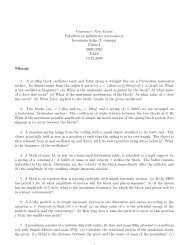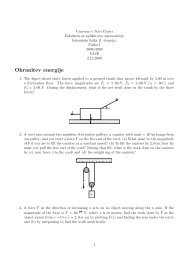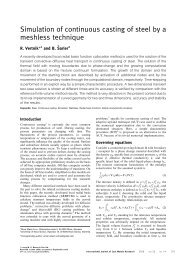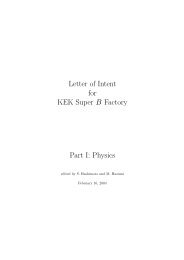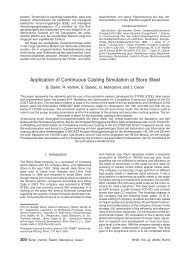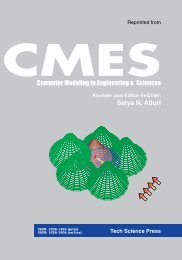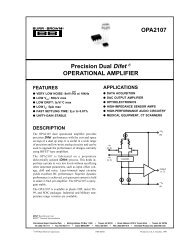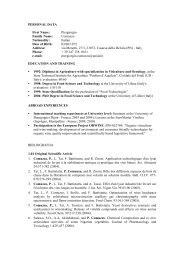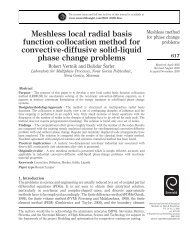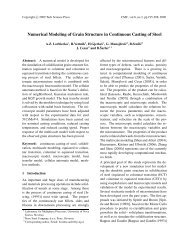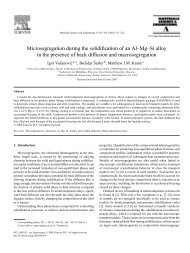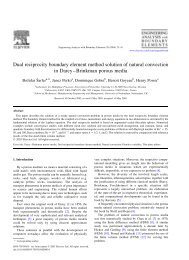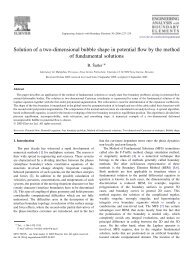Letter of Intent for KEK Super B Factory Part I: Physics
Letter of Intent for KEK Super B Factory Part I: Physics
Letter of Intent for KEK Super B Factory Part I: Physics
Create successful ePaper yourself
Turn your PDF publications into a flip-book with our unique Google optimized e-Paper software.
in flavor physics, and more importantly, to distinguish between different new physics models<br />
by a close examination <strong>of</strong> the flavor structure. Comprehensive studies <strong>of</strong> B meson decays in<br />
the clean e + e − environment provide the ideal solution <strong>for</strong> this purpose, which is not possible at<br />
LHC nor even at the future linear collider.<br />
These provide the primary motivation <strong>for</strong> <strong>Super</strong><strong>KEK</strong>B, a major upgrade <strong>of</strong> <strong>KEK</strong>B. Its design<br />
luminosity is 5 × 10 35 cm −2 s −1 , which is 50 times as large as the peak luminosity achieved by<br />
<strong>KEK</strong>B. Various FCNC processes, such as the radiative decay b → sγ, the semileptonic decay<br />
b → sl + l − , and the hadronic decays b → s¯qq and b → d¯qq, can be studied with unprecedented<br />
precision. All <strong>of</strong> these processes are suppressed in the Standard Model by the GIM mechanism,<br />
and there<strong>for</strong>e the effect <strong>of</strong> new physics is relatively enhanced. New observables that are currently<br />
out <strong>of</strong> reach will also become accessible. In addition to B meson decays, FCNC processes in τ<br />
and charm decays will also be studied at <strong>Super</strong><strong>KEK</strong>B.<br />
The Belle detector will be upgraded to take full advantage <strong>of</strong> the high luminosity <strong>of</strong> <strong>Super</strong><strong>KEK</strong>B.<br />
In spite <strong>of</strong> harsh beam backgrounds, the detector per<strong>for</strong>mance will be at least as<br />
good as the present Belle detector and improvements in several aspects are envisaged. Table 1<br />
summarizes the physics reach at <strong>Super</strong><strong>KEK</strong>B. As a reference, measurements expected at LHCb<br />
are also listed. One <strong>of</strong> the big advantages <strong>of</strong> <strong>Super</strong><strong>KEK</strong>B is the capability to reconstruct rare<br />
decays that have γ’s, π 0 ’s or neutrinos in the final states. There are several key observables in<br />
Table 1 that require this capability. Also important are time-dependent CP asymmetry measurements<br />
using only a K0 S and a constraint from the interaction point to determine the B decay<br />
vertices. Examples include B0 → K∗0 (→ K0 Sπ0 )γ, π0K 0 S and K0 SK0 SK0 S . These fundamental<br />
measurements cannot be carried out at hadron colliders.<br />
Figure 1(a) shows a comparison between time-dependent CP asymmetries in B0 → J/ψK0 S ,<br />
which is dominated by the b → c¯cs tree process, and B0 → φK0 S , which is governed by the b →<br />
s¯ss FCNC (penguin) process. It demonstrates how well a possible new CP -violating phase can be<br />
measured. Such a new source <strong>of</strong> CP violation may revolutionize the understanding <strong>of</strong> the origin<br />
<strong>of</strong> the matter-dominated Universe, which is one <strong>of</strong> the major unresolved issues in cosmology.<br />
Figure 1(b) shows correlations between time-dependent CP asymmetries in B0 → K∗0γ and<br />
B0 → φK0 S decays in two representative new physics models with different SUSY breaking<br />
scenarios; the SU(5) SUSY GUT with right-handed neutrinos and the minimal supergravity<br />
model. The two can be clearly distinguished. This demonstrates that <strong>Super</strong><strong>KEK</strong>B is sensitive<br />
to a quantum phase even at the GUT scale. Note that these two models may have rather similar<br />
mass spectra. It will there<strong>for</strong>e be very difficult to distinguish one from the other at LHC. If<br />
SUSY particles are discovered at LHC, the origin <strong>of</strong> SUSY breaking will become one <strong>of</strong> the<br />
primary themes in elementary particle physics. <strong>Super</strong><strong>KEK</strong>B will play a leading role in such<br />
studies.<br />
We emphasize that the example above is just one <strong>of</strong> several useful correlations that can be<br />
measured only at <strong>Super</strong><strong>KEK</strong>B. The true value <strong>of</strong> <strong>Super</strong><strong>KEK</strong>B is a capability to observe the<br />
pattern as a whole, which allows us to differentiate a variety <strong>of</strong> new physics scenarios. It is<br />
so to speak “DNA identification <strong>of</strong> new physics”, in that each measurement does not yield a<br />
basic physical parameter <strong>of</strong> the new physics but provides an essential piece <strong>of</strong> the overall flavor<br />
structure. This strategy works better when we accumulate more data. Thus the target annual<br />
integrated luminosity <strong>of</strong> 5 ab −1 is not a luxury but necessity, and stable long-term operation <strong>of</strong><br />
<strong>Super</strong><strong>KEK</strong>B is necessary to meet the requirements.<br />
Determination <strong>of</strong> the Unitarity Triangle will also be pushed <strong>for</strong>ward and will be incorporated<br />
in the global pattern mentioned above. This can be done at <strong>Super</strong><strong>KEK</strong>B using redundant<br />
measurements <strong>of</strong> all three angles and all three sides <strong>of</strong> the Unitarity Triangle. In particular, φ2<br />
measurements and Vub measurements require the reconstruction <strong>of</strong> π 0 mesons and neutrinos and<br />
5



